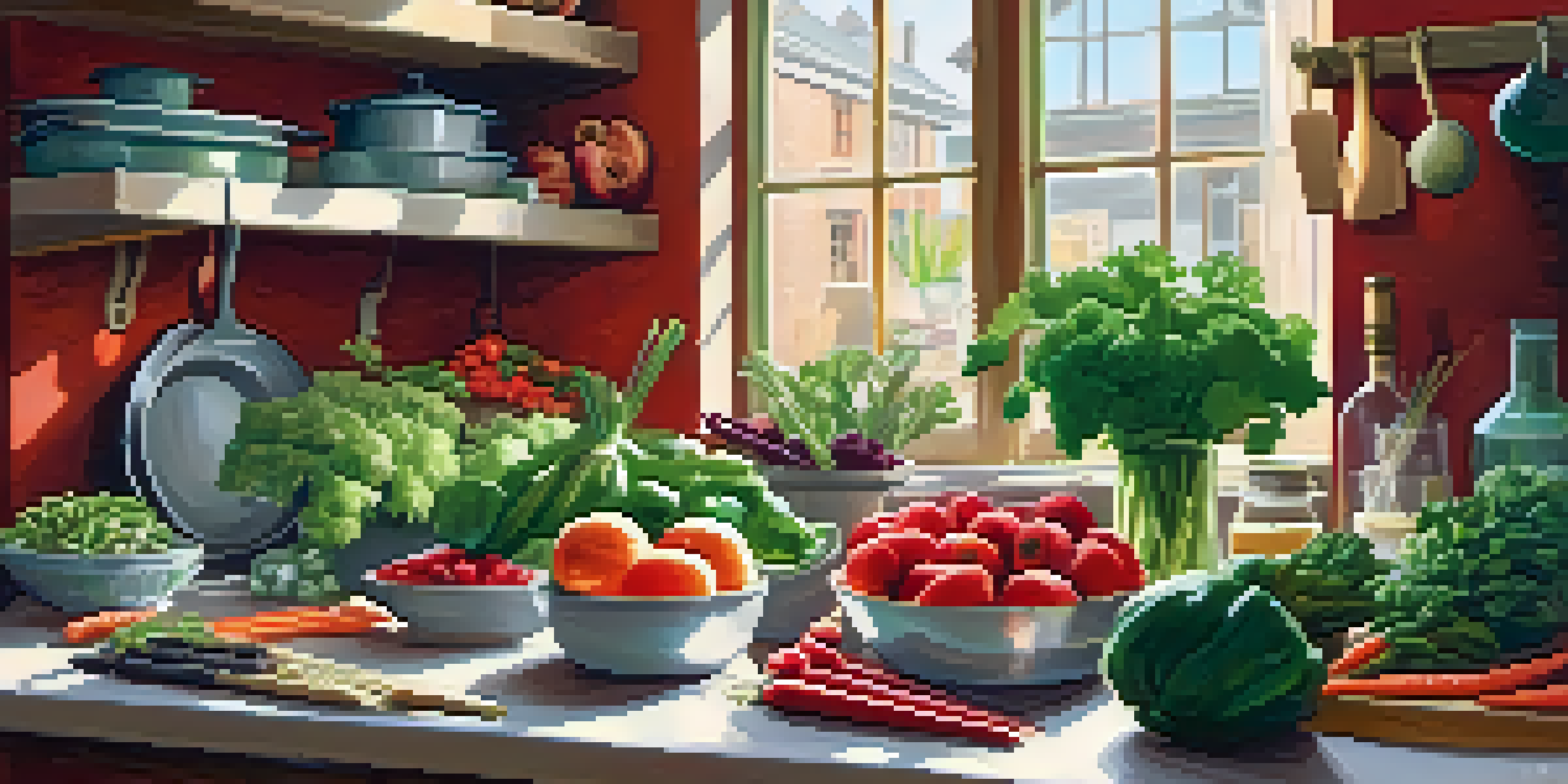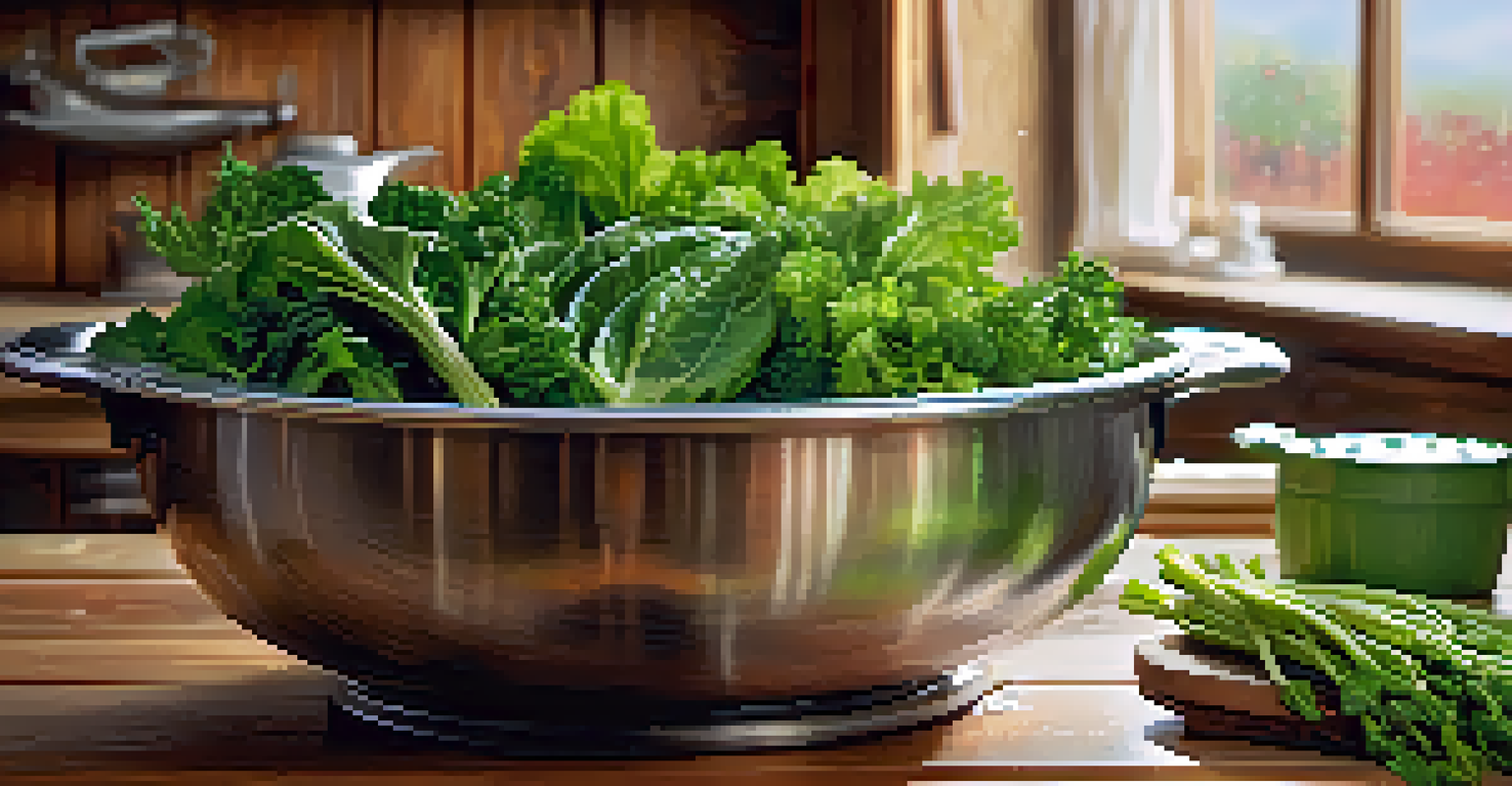Essential Vegan Food Safety Guidelines for Home Cooks

Understanding Cross-Contamination in Vegan Cooking
Cross-contamination is a major concern in any kitchen, and vegan cooking is no exception. It happens when harmful bacteria from one food item transfer to another, which can lead to foodborne illnesses. For instance, using the same cutting board for raw vegetables and raw plant-based proteins without cleaning it in between can pose a risk.
Food safety is not just a priority; it’s a way of life.
To minimize this risk, it’s important to have separate utensils and cutting boards for different food groups. Labeling these tools can also help ensure that you don’t mix them up. Keeping your cooking area organized and clean is key to preventing cross-contamination.
Remember, a little extra care goes a long way. By being mindful of cross-contamination, you can create a safer cooking environment, not just for yourself but for anyone who shares your meals.
Proper Food Storage Techniques for Vegan Ingredients
Storing your vegan ingredients properly is crucial for maintaining their freshness and safety. Different foods require different storage methods; for example, leafy greens should be kept in a breathable container, while grains can be stored in airtight jars. This helps to keep them free from pests and prolongs their shelf life.

Temperature control is also important. Perishable items like tofu or tempeh should be refrigerated immediately after purchase. Establish a routine to check your pantry and fridge regularly, discarding any expired or spoiled items.
Prevent Cross-Contamination
Using separate utensils and cutting boards can significantly reduce the risk of harmful bacteria transferring between food items.
By implementing proper storage techniques, you not only reduce food waste but also ensure that your meals are safe and delicious. A well-organized kitchen makes it easier to grab what you need without second-guessing the safety of your ingredients.
The Importance of Thoroughly Washing Produce
Even though fruits and vegetables are plant-based, they can still harbor dirt and harmful bacteria. That’s why thoroughly washing your produce before use is essential. Rinsing them under running water is usually enough, but for leafy greens, a gentle scrub can help remove any stubborn residues.
The kitchen is a place of transformation, where health begins with safe practices.
Using a produce brush for hard-skinned fruits and vegetables can further ensure they’re clean. This extra step can make a significant difference, especially when you consider that some pesticides and waxes can cling to the surface.
Taking the time to wash your produce not only enhances the flavor of your meals but also protects you and your loved ones from potential foodborne illnesses. Clean ingredients lead to healthier, tastier dishes!
Understanding Food Expiration Dates and Labels
Navigating food expiration dates can sometimes feel like deciphering a secret code. Understanding these labels—like 'sell by,' 'best by,' and 'use by'—is crucial for food safety. 'Best by' indicates optimal quality, while 'use by' suggests the last date for safety.
For vegan ingredients, it’s also important to recognize that some products may still be safe to consume past their 'best by' dates, depending on their storage conditions. Always use your senses; if something looks, smells, or tastes off, it’s best to err on the side of caution.
Store Vegan Foods Safely
Proper storage techniques, like using breathable containers for greens and airtight jars for grains, help maintain freshness and prevent spoilage.
Being aware of these labels can help you make informed decisions about what to keep and what to toss. This not only keeps your meals safe but also helps you save money by reducing food waste.
Safe Cooking Temperatures for Vegan Dishes
While plant-based foods may not carry the same risks as meat, cooking them to the right temperature is still important. For instance, ensuring that tofu is heated to at least 165°F helps kill any potential bacteria. Using a food thermometer can take the guesswork out of this process.
Different vegan dishes may require different cooking times and temperatures. For example, lentils should be cooked until tender, while baked goods need to reach a certain internal temperature for safety. Familiarizing yourself with these specifics can enhance your cooking skills.
By cooking your vegan dishes to the appropriate temperatures, you not only ensure safety but also achieve better flavors and textures. A well-cooked dish is not just safe; it’s also delicious and satisfying!
Hygiene Practices to Maintain in the Kitchen
Good hygiene is the backbone of food safety in any kitchen. This includes washing your hands before and after handling food, especially after touching raw ingredients. It’s a simple yet effective way to prevent the spread of germs and bacteria.
In addition to handwashing, ensure your kitchen surfaces and utensils are clean. A quick wipe down with a food-safe disinfectant can make a big difference, especially after preparing raw ingredients. Keeping your space tidy fosters a safer cooking environment.
Wash Produce Thoroughly
Carefully washing fruits and vegetables is essential to remove dirt, bacteria, and pesticides, ensuring safer and tastier meals.
Adopting these hygiene practices will not only protect you but also elevate the overall quality of your cooking. A clean kitchen is a happy kitchen, leading to more enjoyable cooking experiences!
Educating Yourself on Vegan Food Safety Resources
The world of vegan cooking is ever-evolving, and staying educated on food safety is key. Numerous resources are available, including websites, books, and courses focused on vegan culinary practices. These can provide valuable insights into safe food handling and preparation.
Joining communities, either online or in-person, can also be beneficial. Engaging with fellow vegan cooks offers opportunities to share tips, experiences, and even recipes, enhancing your culinary journey. Learning from one another creates a supportive environment for all skill levels.

Investing time in education is an excellent way to ensure that your cooking practices are safe and up to date. The more you learn, the more confident you’ll feel in the kitchen, allowing you to experiment and enjoy your vegan cooking adventures!
Sharing Your Knowledge on Vegan Food Safety
Once you’ve mastered vegan food safety guidelines, why not share your knowledge with others? Whether it’s through hosting cooking classes, writing blogs, or simply chatting with friends, spreading awareness can make a big impact. Everyone benefits from knowing how to keep their meals safe and enjoyable.
Sharing your experiences can also encourage others to adopt safer practices in their kitchens. For example, if you’ve discovered a great way to store tofu, sharing that tip could help someone avoid spoilage and waste. Your insights could inspire others to become more mindful in their cooking.
Ultimately, fostering a community focused on vegan food safety not only enhances individual cooking experiences but also creates a larger culture of health and wellness. Together, we can inspire safer, more delicious plant-based meals!